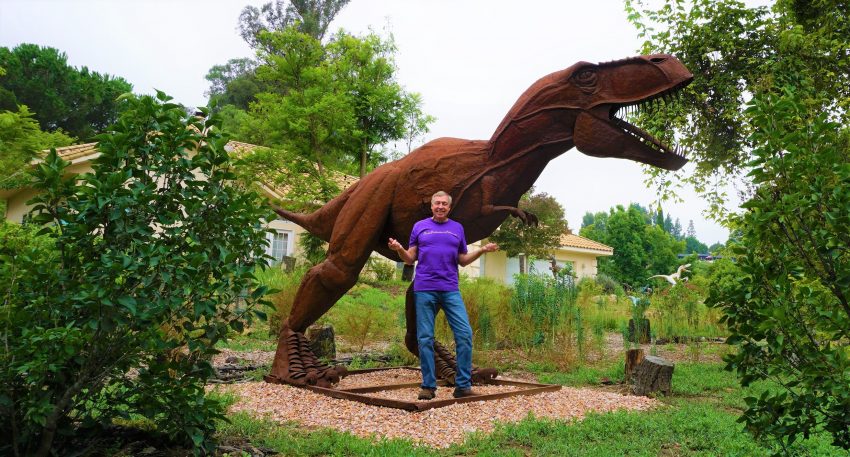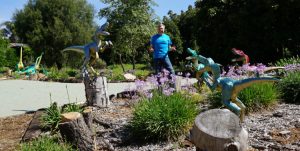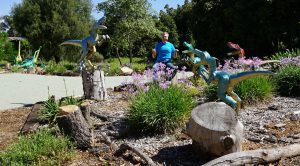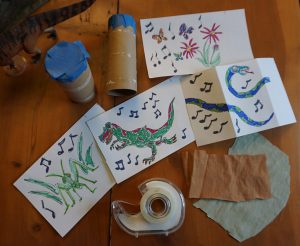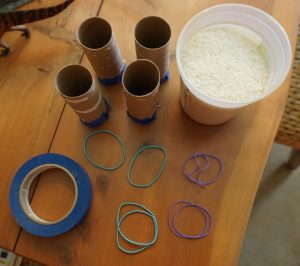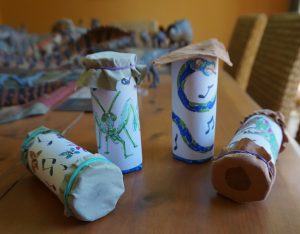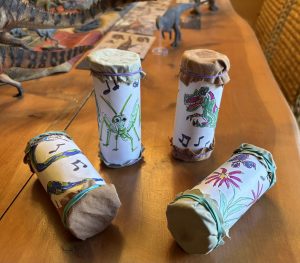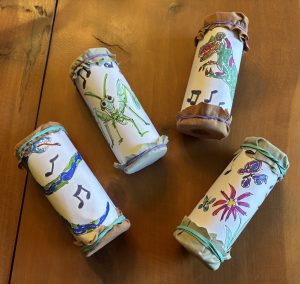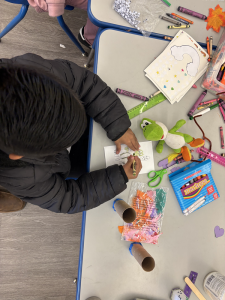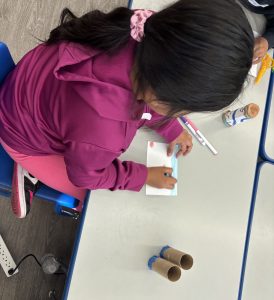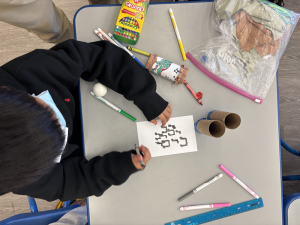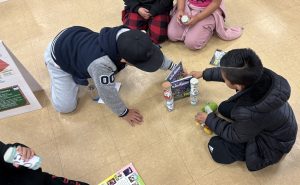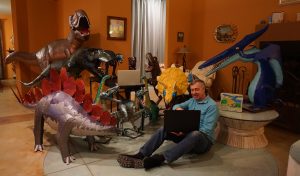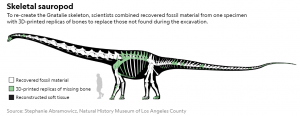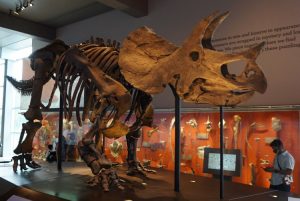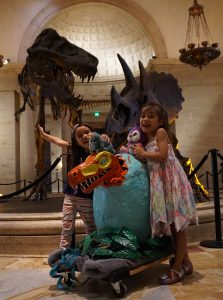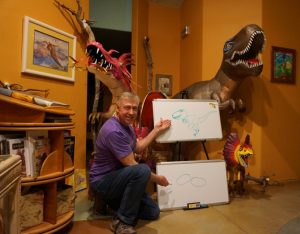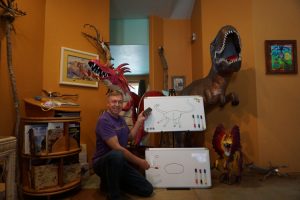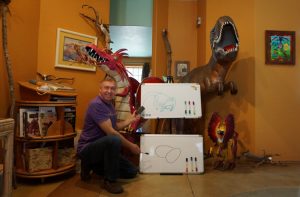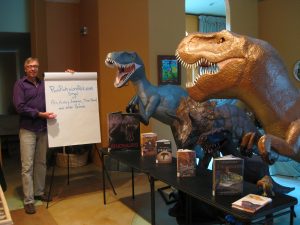Did Dinosaurs create Music? Their descendants are birds (at least from the non-avian theropods branch). Birds produce tremendous amounts of Music. So, what sounds did Dinosaurs make?
The Jurassic Park & World Movies gave us Terrifying Roars and Raptor’s call sounds that will stick in our memories. However, these were created by Sound Technicians using a variety of animal roars, screeches, cries and calls combined. Did You know Gary Rydstrom was the Sound Designer for the Jurassic Park Movies? He used baby elephant squeals, alligator gurgles and tiger snarls for the T-Rex. The breathing was the sound of air escaping a whale’s blow hole. For Dilophosaurus, swans hooting, rattle snakes & hawks brought them to life. The Raptors were owls and the mating sounds of tortoises – really! In Jurassic World Al Nelson expanded on these sounds to give the Raptors more lines and individual personalities. African Cranes, hissing geese, dogs and horses were used to increase the Raptors vocabulary. High pitched sounds paired with the low voice of a walrus or tiger gives the impression of size & weight. The Brachiosaurus is a braying donkey and the Apatosaurus emoting tigers & dogs.
But what sounds did Dinosaurs really make? Well, no one knows for sure. Scientists believed many dinosaurs relied on deep base vibrations that humans couldn’t hear but definitely would feel. Since their closest relatives are crocodiles & birds many may have made throaty gargling noises. Imagine those amplified to reflect the size of these thundering Dinosaurs! Pretty Scary to me. I like to think that the smaller dinosaurs would have chirped and sang similar to birds today. Imagine a T-Rex that could mimic the sound of the Laughing Kookaburra. It makes me laugh just thinking about it. Listen to the trainers get huge laughs from telling their jokes to a Kookaburra Bird in Australia.
https://www.youtube.com/watch?v=UiMxZIVJjb0
What if Raptors could copy any sound they heard like the Lyrebird. Raptors were very intelligent. I believe they would use this talent to attract prey. Check out the video of David Attenborough observing a Lyrebird. Also, in Australia.
https://www.youtube.com/watch?v=VjE0Kdfos4Y
Below are a couple of links to guesses of dinosaur sounds.
https://www.youtube.com/watch?v=XcBoY_aEVj8
Note: Elasmosaurus & Mosasaurus are not Dinosaurs. They are Marine Reptiles. Quetzalcoatlus is not a Dinosaur either but a Flying Reptile. Different parts of a Family Tree.
https://www.youtube.com/watch?v=3a9hN-CvqUw
A larynxes or syrinxes (vocal organ in birds) is rarely found in the fossil record. In 2023 an article was published with the findings of Junki Yoshida, Yoshitsugu Kobayashi & Mark Norell a Larynx in Pinacosaurus grangeri. Future research may provide more clues to the sounds Dinosaurs had the ability to make. Perhaps my laughing T-Rex and Mimicking Raptors aren’t too far-fetched after all!
This is a great video I found on YouTube by The Overseer on 2-4-2024. He covers 3 Dinosaurs but provides food for thought on what we know, can speculate and hope for future discoveries to shed more light. Enjoy!
https://www.youtube.com/watch?v=Fqf8EYdCehw
Music & Entertainment is the theme for March at ReadingtoKids. Our 3rd Graders were treated to “My First Orchestra Book” by Genevieve Helsby, which came with a CD for playing the music of each instrument. For our craft we made musical shakers using cardboard tubes, paper, cloth, rubber bands and rice. Taping the ends of the tube – one then adding about 6 tablespoons of rice then the other. Drawing & Coloring our design on regular paper which we had cut to fit around the tubes slightly overlapping. The paper was attached with clear or invisible tape. Scrapes of cloth were secured at each end of the tubes with colorful rubber bands to hide the tape. My shakers were decorated with Butterflies, a Grasshopper, a Snake and of course a Dinosaur.
Did you know the first Grasshoppers appeared in the Early Triassic Period 250 MYA (Million Years Ago), Butterflies in the Mid Cretaceous 100 MYA, Snakes in the Middle Jurassic 167 MYA. The kids had fun with their own favorites.
Stay Tuned for More Dinosaur Fun Facts, Fiction & Crafts!
Consider a Membership with the Museum. In addition to Supporting Their Valuable Work there are Benefits to You. Special Preview Events for Members Only as well as Virtual Access Exclusive for Members. Below are 3 of my favorites Museums. For more information and access to general public eLearning check out the links below.
The Natural History Museum of Los Angeles County www.nhm.org under Research & Collections / Digitized Collections will allow you to browse their Collections. Check out the latest Activities on their site. Look for Gnatalie the Green Dinosaur! Plus T-Rex in 3D a Prehistoric Movie!
The American Natural History Museum www.amnh.org You will find eLearning for Families, Students & Educators. Explore the Museum Virtually. Check Out SciCafe: Video Talks and Meet the Icons: Stories behind the Exhibits! There are Video Series covering Behind the Scenes at the Museum with Space & Dinosaur Explainers.
Chicago’s Field Museum www.fieldmuseum.org You can talk to “Maximo the Titanosaur” online, Yes Really! Visit Sue the largest T-Rex discovered! Check Out “Brain Scoop” and the Learning Resources – many are also in Spanish.
Check Out Your Libraries eBooks. My local Library has over 900 eBooks on Dinosaurs! Here are four books for Drawing Dinosaurs that you might find at your Library. Ask your Librarian about others.
1-2-3 Draw Dinosaurs and other Prehistoric Animals A step by step guide by Freddie Levin (2001)
Draw 50 Dinosaurs and other Prehistoric Animals by Lee J. Ames (1977)
Draw it Dinosaurs by Patricia Walsh (2006)
I Can Draw Dinosaurs by Terry Longhurst (2003)
Stay Safe & Well
“Encouraging the Appreciation of Art and Education through the Inspiration of Dinosaurs”
Paul & Prehistoric Pals
Your feedback is appreciated, comment below or email:
Thank you!
